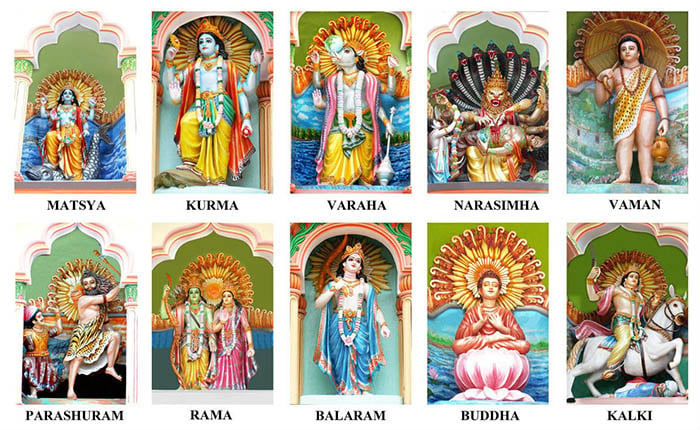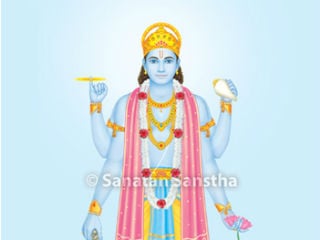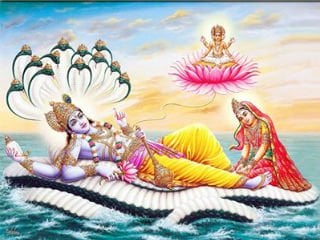Contents
Information on ten main Incarnations of Shri Vishnu is given ahead.

| Incarnation | Tithi (Lunar day) of birth | Yug (Era) | Vishnu-tattva % | Manifest Shakti (Divine Energy)% | Name of Shakti | Ability % | ||
|---|---|---|---|---|---|---|---|---|
| Cre-ation | Suste- nance |
Disso- lution |
||||||
| Matsya (Fish) | Chaitra Shukla 3 (Matsyapurana; Ashadha Shukla 11 (Varahapurana) | Satya | 20 | 20 | – | 40 | 50 | 10 |
| Kurma (Tortoise) | Vaishakha Pournima | Satya | 30 | 30 | – | 30 | 50 | 20 |
| Varaha | Bhadrapada Shukla 2 or 3 | Satya | 40 | 40 | – | 20 | 50 | 30 |
| Nrusinha | Vaishakha Shukla 14 | Satya | 45 | 45 | Saraswati | 20 | 50 | 30 |
| Vaman | Bhadrapada Shukla 12 | Satya | 50 | 50 | Brahman | 20 | 50 | 30 |
| Parashuram | Vaishakha Shukla 3(AkshayyaTrutiya) | Satya | 65 | 65 | Parashu | 20 | 50 | 30 |
| Shriram | Chaitra Shukla 9 | Treta | 75 | 75 | Sita | 20 | 50 | 30 |
| Shrikrushna (Total Incarnation) | ShravanKrushna 8 | Dwapar | 100 | 100 | Ashta and Dasha Mahasiddhi | 20 | 50 | 30 |
| Buddha | Ashwin Shukla 9 | Kali | 50 | 70 | – | 20 | 50 | 25 |
| Kalki | Note 1 | Kali | 80 | 100 | – | 15 | 50 | 35 |
Note 1 – At the end of the Kaliyug(Era of strife) on the day of Shravan Shukla 3, the Incarnation of Kalki will be born. (Kalkipurana).
1. Matsya
A. Mission
- Protecting the seed of Creation at the time of Dissolution of the world is the mission of Incarnation of Matsya. Each time there is Dissolution of the world, all the things in the world are preserved in seed form by the Incarnation of Matsya. The world is then recreated from that seed by the next Kurma Incarnation.
- Slaying of demons Hayagriva (Bhagawatpurana), Shankhasur (Skandapurana).
B. Idol
- Entirely in fish form
- The torso is that of a man. It has four weapons of Shri Vishnu in the four hands.
C. Implied meaning
Just as a fish swims against the stream of a river, against the flow towards its origin, so also a seeker should go to his place of origin, that is, to Supreme God.
2. Kurma
A. Mission
- Creation : Assuming the form of a tortoise, Prajapati created progeny. This is His karma. His name Kurma has been derived from the word karma. Later, He has also been referred to as Kashyap. Kashyap was Prajapati, the creator of progeny. Since the entire Creation was created by Kashyap, He was believed to be the Kurma. From this, we realise that the mission in the tortoise form is basically that of Prajapati.
- Supporting all functions : At the time of samudramanthan, the tortoise who supported the Mandar Mountain on its back that was vibrating due to the strength of the arms of Deities and demons and rotating, was the unfathomable Kurma Incarnation. We can imagine its enormousness from the fact that it considered the vibration and rotation of the Mountain on its back as mere scratching of its body.
B. Idols
Idols of Nrusinha and Varaha are found all over Bharat in abundance; however, Idols of the Kurma Incarnation are rarely found independently.
C. Implied meaning
Just as a tortoise withdraws its four limbs, head and tail into its shell, so must we control our shadripus(The six foes).
3. Varaha
A. Mission
- Destruction of demons : A demon named Hiranyaksha abducted the earth and took it to Hell. Shri Vishnu then assumed the form of a boar, retrieved the earth from Hell with Its tusks, and installed it on the head of the serpent Shesha. It then slew Hiranyaksha. Shri Vishnu assumed this Incarnation at the beginning of the Varaha-kalpa. Imparting knowledge : In this Incarnation, Shri Vishnu preached Spirituality to Sanatkumar and narrated the Varahaopanishad to Rhubhu.
B. Idols
According to Vaikhanas-agam (Vaikhanas standsfor followers of Sage Vaikhanas and agam means tradition), Idols are of the types mentioned ahead.
- Yadnyavaraha : It is seated on a throne with Deity Shridevi on one side and Bhudevi on the other.
- Pralayavaraha : Only Bhudevi is beside it.
- Nruvaraha : The body is that of a man and the head of a boar. Some Idols also hold Shri Vishnu’s weapons.
C. Implied meaning
- A varaha does not retreat while attacking an enemy even at the cost of its life. Similarly, a seeker should not give up spiritual practice even if it costs his life.
- The seventh chakra of Kundaliniis called Ekadantaor Narayan.
4. Narsimha (Nrusimha)
A. Mission
- Slaying the demon Hiranyakashyapu.
- Lakshmi-Narsimha is the family Deity of some families. Narsimha is the family Deity of the Royal family of Vijayanagar.
B. Idol
The body is of a man and the head of a ferocious lion.
C. Implied meaning of some incidents
- Manifestation of Narsimha from a pillar shows the existence of the Supreme God in animate as well as inanimate Creation.
- Hiranyakashyapu signifies ignorance. Narsimha slew him by tearing open his abdomen, thus liberating the jiva(Embodied soul) situated at the level of the navel.
D. Ritualistic worship
It is difficult to tolerate the Tej(Radiance) of Nrusimha. Hence, He is worshipped by adorning the back of His Idol with eyes, whiskers etc. Similarly, the eyes of Balaji of Tirupatiare half open since it is difficult to tolerate His Tej. Sacrifice of a goat is offered to Nrusimha. (While sacrificing an animal for the completion of a specific task, if the animal walks willingly towards the Deity of sacrifice, it not only ensures the completion of the task, but the animal also gets liberated. This is the noble intention underlying animal sacrifice.)
E. Nar-Narayan
Nar was created from the human part of Narsinha, and Narayan from the face of a lion.
5. Vaman (The dwarf)
Vaman is the son of Kashyap and Aditi.His other Name is Urukram. Urukram means one who has a wide stride.
A. Mission
He kept Bali, a demon king, in bondage.
B. Idols
- ·Idols of Vaman : Short, with a paunch, the facial expression of a child, adorning a janeu (Sacred thread), two hands – holding an umbrella in one and a baton in the other.
- Trivikram : An expansive form.
C. Implied meaning
The three footsteps that Vaman asked King Bali for, describe the all-pervading nature of Shri Vishnu. With His three footsteps, Vaman encompassed the earth, space and the sky (or the earth, Heaven and Hell).
6. Parashuram
One comes across stories about Parashuramin the Ramayan, the Mahabharat and in some Puranas. There is no separate Purana about Parashuram unlike the Incarnations preceding Him.
A. Parents
Sage Jamadagni (of the Bhrugu dynasty) and Renuka were the parents of Parashuram. Renuka is also known as Ekvira in Maharashtra and Yallama in Karnataka. Renuka was the daughter of a Kshatriya (Warrior). However, Jamadagni being a Brahman, Parashuram too became a Brahman. The Ashram ofSage Jamadagni was situated on the banks of River Narmada.Parashuram was born there in the nineteenth Tretayug (in the transition period between the Treta and Dwaparyug according to the Mahabharat). Renu means particles of earth. Renuka performed the spiritual practice of the water element, meaning,she was a water-seeker. Hence, she could fetch water in of wet clay. Jamadagni performed the spiritual practice of the fire element. Jamat is a type of fire. Jamat also means are solute wish.
B. Mission
- Slaying of unrighteous Kshatriyas : Sage Valmiki has referred to Him not as a slayer of Kshatriyas but of kings. From this an inference can be made that Parashuram did not kill all Kshatriyas all together, but only the Kshatriya kings who were evil.Kartavirya abducted Kamadhenu (The Divine wish-fulfilling cow) and her calf from Sage Jamadagni’s Ashram. This happened in Parashuram’s absence. Upon His return, realising what had happened, Parashuram vowed to slay Kartavirya. In the ensuing battle between them on the banks of River Narmada, Parashuram slew Kartavirya. Thereafter, complying with His father’s directives He embarked on a pilgrimage for austerities.After Parashuram left, to avenge the death of Kartavirya,Haihaya beheaded Sage Jamadagni. When this news reached Parashuram, He returned to the Ashram. There were twenty-one arrow wounds on the dead body of Jamadagni. Seeing them,Parashuram instantly pledged that He would circumambulate the earth twenty-one times to punish and rid the earth of evil Kshatriyas and Haihaya because of the slaying of a Brahman by them. According to this vow, Parashuram slayed the unrighteous Kshatriyas and retreated for penance to the Mahendra Mountain.Whenever there was a rise in evil warriors, He would return and slay them. He completed twenty-one such missions. He fought the last battle on the Samanta-panchaka. There, He washed His axe soaked in the blood of the Kshatriyas and lay it down.
- Erecting temples of Kshetrapaldevata (Deities of territories) : While circumambulating the earth twenty-one times, Parashuram established 108 Shaktipeethas, meaning, pilgrimage centres – temples of territorial Deities. Before Parashuram, these places were known to Saints; however, none erected temples or established peethas there.
C. Characteristics
- अग्रतःचतुरोवेदाःपृष्ठतःसशरंधनुः।
इदंब्राह्मम्इदंक्षात्रंशापादपिशरादपि।।
Meaning :Parashuram, who knows all the four Vedas by heartcarries abow and arrow on His back (meaning He is courageous); effectivelythis means that there is presence of Brahmatejand Kshatratej in Him. Whoever opposes Him will be vanquished by Parashuram either with a curse or an arrow.
- Passing His Tej to Shriram : Upon hearing about the fame of Shriram (the son of Dasharatha), Parashuram wanted to test Shriram’s bravery and hence, He once obstructed His path. He offered His bow to Shriram and told Him to bend it and mount an arrow on it. When Shriram complied and asked where He should shoot the arrow, Parashuram replied, “Nullify my activity on this land of Kashyap”. Shriram obliged. Then, Parashuram gifted that bow to Shriram and thus passed His Kshatratej to Shriram.
- The best archery teacher : After laying down His arms, Parashuram gave up His feeling of hatred towards Kshatriyas and began teaching archery to Brahmans as well as Kshatriyas without prejudice. Great archers mentioned in the Mahabharat (such as Bhishmacharya, Dronacharya, etc.) were disciples of Parashuram.
- Generous : Due to His mission of destroying the Kshatriyas, He became the master of entire earth. As a result, He also acquired the right to perform the Ashwamedha Yadnya. So He first bathed in all the places of pilgrimage, circumambulated the earth thrice and then performed the Yadnya. At the end of the Yadnya, Parashuram offered the entire land He had acquired to the officiating priest of the sacrificial fire, Sage Kashyap.
- Creation of new land :Kashyap realised that so long as Parashuram continued to live on earth, Kshatriyas would not prosper. Hence, He said to Parashuram, “The land you have offered me in the Yadnya now belongs to me. You have no right to stay on my land anymore”. Thereafter, making the sea recede, Parashuram created His own new territory. The area from Vaitarana to Kanyakumari is known as the Parashuramkshetra (Parashuram’s territory).
- He is one among the Saptachiranjivi (Seven immortals); however, Mahabharat states that during the manvantara ( period) He will renounce His body.
D. Idol
The body is huge like that of Bhima. It has matted hair locks and sports a bow on the shoulder and an axe in the hand.
E. Ritualistic worship
Since Parashuram is an Incarnation of Shri Vishnu, He is an Upasyadevata (Deity of worship). His birthday, which comes on Vaishakha Shukla 3, is celebrated as avrat (Vowed religious observance) as well as a religious festival.
7. Shriram
The name ‘Ram’ was prevalent even before Ram’s birth.He belongs to the Sun dynasty.After His victory at Lanka, when Ram returned with Sita to Ayodhya, He began to be addressed as Shriram. ‘Shri’ is an adjective for God. Upon Ram demonstrating His Godhood, everyone started addressing Him as Shriram.He observed all the codes of Righteousness; that is why he is referred to as ‘Maryada Purushottam’.Shriram was ideal in all respects – ideal brother, ideal husband, ideal friend, ideal king and ideal enemy.
8. Shrikrushna
Since Shrikrushna is aPurnavatar (Absolute Incarnation), He is not known as an Incarnation but as Shri Vishnu Himself, who has assumed an Incarnation.
9. Buddha
The control of shrout-smart karmas such as Yadnya went into the hands of the demons. Since they did not have the right to perform these things, there was anarchy everywhere. At that time, Bhagawan Buddha incarnated, had discussions with the demons, enticed them and diverted them from performing a Yadnya.
Bhagawan Buddha, the 9th Incarnation of Shri Vishnu, and the founder of Buddha sect Gautam Buddha are different.The reasons are mentioned ahead.
| Bhagawan Buddha | Gautam Buddha | |
|---|---|---|
| 1. Varna | Brahman | Kshatriya from Ikshvaku dynasty |
| 2. Birth place | Keekatdesh (Gaya), Bihar | Lumbini, Nepal |
| 3. Tithi of birth | Pousha, Shukla 7 | VaishakhaPournima |
| 4. Period | 1000 years after the commencement of Kaliyug (During the days of Jin, the father of Bhagawan Buddha) |
2700 years after the commencement of Kaliyug |
Reasons why Bhagawan Buddha and Gautam Buddha appear to be the same
- In a Sanskrut dictionary titled ‘Amarkosha’, the names Bhagawan Buddha and Gautam Buddha are given as synonyms. Due to the publicity ‘Amarkosha’ received, people started believing that both are the same.
- Agnipurana describes the meditative state of Bhagawan Buddha. Subsequently, Buddhists sculpted Idols of Gautam Buddha based on this description and hence, Idols of both the Buddhas became identical.
10. Kalki
A. Birth
He is the tenth or twenty-first Incarnation of Shri Vishnu. He will be born on Shravan Shukla 3at the end of the Kaliyug to a Brahman named Vishnuyashas in the Shambalvillage in Kikat. His gotra will be Parashar.
B. Mission
He will embark on the conquest of the earth on His horse named Devdatta. He will destroy the evil & unrighteous and reinstate Dharma (Righteousness). He will destroy His enemies, the evildoers who have become foreigners by conduct, and rule the world. The priest Yadnyavalkya will assist Him in this mission and finally at the age of twenty-five, He will renounce His body at the confluence of the Rivers Ganga and Yamuna. Thereafter, Krutayug (Satyayug)will commence. These are the predictions made in Kalkipurana.
C. Idols
The Hayshirshapancharatra and the Agnipurana describe the image of Kalki in two different ways – one with two arms and the other with four arms.Kalki wields a sword in one hand, is enraged, is seated on a horse, is mighty, is the destroyer of evildoers and has two arms.

 Forms and Family of Shri Vishnu
Forms and Family of Shri Vishnu Science of the idol of Shri Vishnu
Science of the idol of Shri Vishnu Vaikunth chaturdashi is an invaluable opportunity granted to us to worship Deity Shri Vishnu
Vaikunth chaturdashi is an invaluable opportunity granted to us to worship Deity Shri Vishnu Why a specific Name of Shri Vishnu is used for a specific task ?
Why a specific Name of Shri Vishnu is used for a specific task ?